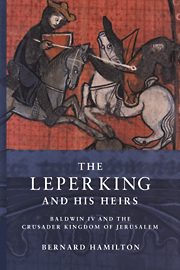Book contents
- Frontmatter
- Dedication
- Contents
- List of illustrations
- Acknowledgements
- List of abbreviations
- Maps
- Genealogies
- Glossary
- Prologue
- 1 The sources for Baldwin IV's reign
- 2 Baldwin's childhood
- 3 The kingdom
- 4 The international status of the kingdom
- 5 The king's minority
- 6 Western aid. William of Montferrat and Philip of Flanders
- 7 The victor of Mont Gisard
- 8 Prince Reynald's initiative
- 9 The dying king
- 10 The heirs of the leper king
- Epilogue
- Appendix An evaluation of the leprosy of King Baldwin IV of Jerusalem in the context of the medieval world
- Bibliography
- Index
8 - Prince Reynald's initiative
Published online by Cambridge University Press: 05 February 2015
- Frontmatter
- Dedication
- Contents
- List of illustrations
- Acknowledgements
- List of abbreviations
- Maps
- Genealogies
- Glossary
- Prologue
- 1 The sources for Baldwin IV's reign
- 2 Baldwin's childhood
- 3 The kingdom
- 4 The international status of the kingdom
- 5 The king's minority
- 6 Western aid. William of Montferrat and Philip of Flanders
- 7 The victor of Mont Gisard
- 8 Prince Reynald's initiative
- 9 The dying king
- 10 The heirs of the leper king
- Epilogue
- Appendix An evaluation of the leprosy of King Baldwin IV of Jerusalem in the context of the medieval world
- Bibliography
- Index
Summary
Because of the deep divisions in his kingdom, Baldwin IV sought a two-year truce with Saladin in the late spring of 1180, but whereas Islamic rulers had normally paid the Franks tribute in order to obtain a truce, on this occasion both sides agreed to the terms unconditionally. Saladin was not interested in exploiting Frankish divisions, perhaps because he feared lest that should provoke fresh Byzantine intervention, but welcomed Baldwin's proposal because he wanted to be free to campaign in north Syria and check the growing power of Kilij-Arslan II of Iconium. For that reason he also forced Raymond III of Tripoli to make a truce by invading his county and by mounting a naval assault on Tortosa. Saladin was feeling insecure at this time because the Abbasid Caliph al-Mustadi and his vizier, Zahir al-Din Ibn al-Athir, on whose support Saladin could rely, had died within a few days of each other in the early spring of 1180. He needed the caliph's assent to legitimise his seizure of Zengid lands, and was uncertain whether he would enjoy the same degree of co-operation from the new Caliph al-Nazir and his vizier, Majd al-Din Ibn al-Sahib.
King Baldwin was anxious to give an official explanation to the Emperor Manuel of what had happened in Jerusalem at Easter 1180 and to assure him that the Franks still stood in need of his protection. He sent his most important minister and his closest kinsman, Joscelin of Courtenay, to Constantinople, which is an indication of how important he considered this mission. Before this business had been finished, Manuel died on 24 September 1180 and Joscelin had to spend the winter in the Byzantine capital to complete the negotiations with the new government. Manuel was succeeded by his eleven-year-old son, Alexius II, for whom his mother, Mary of Antioch, was regent, assisted by Manuel's nephew, the protosebastus Alexius.
- Type
- Chapter
- Information
- The Leper King and his HeirsBaldwin IV and the Crusader Kingdom of Jerusalem, pp. 159 - 185Publisher: Cambridge University PressPrint publication year: 2000
- 1
- Cited by



